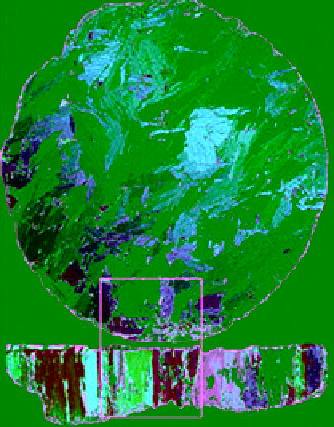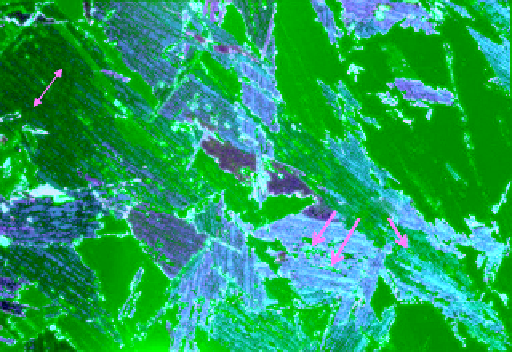Geology Reference
In-Depth Information
(a)
(b)
Figure 4.60
Cross‐polarized view of a circular 100 mm diameter horizontal thin section about 12 mm above the core
bottom together with a vertical thin section of the bottom 12 mm of the core is shown in (a); closeup of the boxed
area, but with different orientations of the polarizers is shown in (b) (photographs by N. K. Sinha, unpublished).
(For color detail, please see color plate section).
transmission spectra revealed that the ratio of the trans-
mittance in the wavelength band 450-600 nm (blue to
orange) was a sensitive indicator of biomass, while the
ratio in the band between 600 and 700 nm (orange to red)
was strongly affected by snow depth.
Fritsen et al.,
[2010]
present measurements and model calculations of the
PAR near the bottom of the sea ice. The estimates vary
from year to year according to the ice growth and the
overlaid snow conditions. Ice algae usually exist within
a layer of consolidated ice platelets underlying the sea
ice [
Welch and Bergmann,
1989]. However, when the ice
growth rate exceeds a certain level, the algae may not be
able to maintain this position. High biomass of algae has
been found at the surface of young ice, in bands within
the FY ice, and within narrow porous layers at the bot-
tom of the ice sheet [
Horner et al.,
1992].
Photomicrographs of thin sections of laboratory made
saline ice were used by
Krembs et al.
[2011] to reveal brine
pocket habitat for organisms at high magnification.
Organisms that reside in brine pockets produce an organic
gelatinous substance, called extracellular polymeric sub-
stances (EPS). This material is responsible for retaining
salts to improve the habitability of primary production.
It also changes the microstructure of the brine pockets.
Krembs et al.
[2011] found that EPS, which is observed
microscopically in the brine inclusions, influences the
geometry of brine inclusions.
Figure 4.61
Cross‐polarized view of a horizontal section in the
skeletal zone exhibiting the algae colonies primarily along
the parallel rows of subgrain boundaries and hence parallel to
the basal planes of the grains or normal to the
c
axis, pointed
out in one of the grains (micrograph by N. K. Sinha, unpub-
lished). (For color detail, please see color plate section).
They attributed this to the differences in the geometrical
distribution of the algae or the influence of skeletal ice
and dissolved organic material. Their measurements thus
confirmed a general observation that maximal algal
accumulation occurs when there is a thin layer of snow
on top of the ice cover. Examinations of the observed



